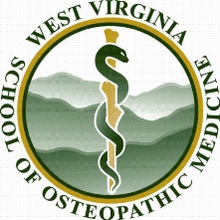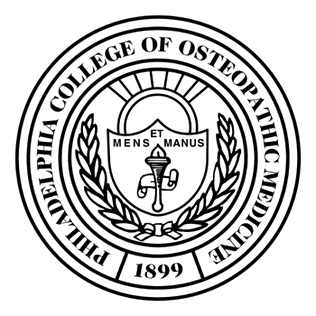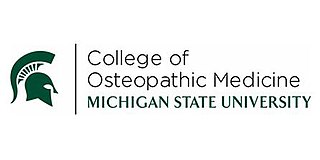Osteopathic medicine is a branch of the medical profession in the United States that promotes the practice of science-based medicine, often referred to in this context as allopathic medicine, with a set of philosophy and principles set by its earlier form, osteopathy. Osteopathic physicians (DOs) are graduates of American osteopathic medical colleges and are licensed to practice the full scope of medicine and surgery in all 50 U.S. states. The field is distinct from osteopathic practices offered in nations outside of the U.S.—in which practitioners are generally considered neither parts of core medical staff nor of medicine itself; rather, they are considered alternative medicine practitioners. The other major branch of medicine in the United States is referred to by practitioners of osteopathic medicine as allopathic medicine.

The West Virginia School of Osteopathic Medicine (WVSOM) is a public medical school in Lewisburg, West Virginia. Founded in 1974, WVSOM is one of three medical schools in West Virginia and the sole institution that grants the Doctor of Osteopathic Medicine (D.O.) degree. WVSOM currently has 778 students, and focuses on primary care and rural medicine.

The American Osteopathic Association (AOA) is the representative member organization for the more than 176,000 osteopathic medical doctors (D.O.s) and osteopathic medical students in the United States. The AOA is headquartered in Chicago, Illinois, and is involved in post-graduate training for osteopathic physicians. Beginning in 2015, it began accrediting post-graduate education as a committee within the Accreditation Council for Graduate Medical Education, creating a unified accreditation system for all DOs and MDs in the United States. The organization promotes public health, encourages academic scientific research, serves as the primary certifying body for D.O.s overseeing 18 certifying boards, and is the accrediting agency for osteopathic medical schools through its Commission on Osteopathic College Accreditation. As of October 2015, the AOA no longer owns the Healthcare Facilities Accreditation Program (HFAP), which accredited hospitals and other health care facilities.

Philadelphia College of Osteopathic Medicine (PCOM) is a private medical school with its main campus in Philadelphia, Pennsylvania, and additional locations in Suwanee, Georgia and Moultrie, Georgia.
Tyler C. Cymet, D.O., FACP, FACOFP, FACHT is a physician in Baltimore, Maryland. Cymet attended Emory University for his premedical undergraduate degree and majored in psychology and anthropology. He then attended medical school at Nova Southeastern University College of Osteopathic Medicine to acquire his medical degree, served as an intern at the Midwestern University Graduate Medical Education system, performed a Primary Care Internal Medicine residency at Yale University, and did additional training at Sinai Hospital of Baltimore.
The Accreditation Council for Graduate Medical Education (ACGME) is the body responsible for accrediting all graduate medical training programs for physicians in the United States. It is a non-profit private council that evaluates and accredits medical residency and internship programs.
The American Association of Colleges of Osteopathic Medicine (AACOM) is a non-profit organization that supports the 41 accredited colleges of osteopathic medicine (COMs) in the United States. These colleges are accredited to deliver instruction at 66 teaching locations in 35 states. In the current academic year, these colleges are educating more than 35,000 future physicians—25 percent of all U.S. medical students. Seven of the colleges are public and 34 are private institutions.

The Lake Erie College of Osteopathic Medicine (LECOM) is a private medical school and academic health center in Erie, Pennsylvania. LECOM has a Branch Campus in Bradenton, Florida and additional locations in Greensburg, Pennsylvania, and Elmira, New York. Founded in 1992, LECOM confers medical (D.O.), dental (DMD), podiatry (DPM), pharmacy (PharmD) degrees, as well as masters and doctoral degrees in the health sciences.
Most physicians in the United States hold either the Doctor of Medicine degree (MD) or the Doctor of Osteopathic Medicine degree (DO). Institutions awarding the MD are accredited by the Liaison Committee on Medical Education (LCME). Institutions awarding the DO are accredited by the Commission on Osteopathic College Accreditation (COCA). The World Directory of Medical Schools lists both LCME accredited MD programs and COCA accredited DO programs as US medical schools. Foreign-trained osteopaths do not hold DO degrees and are not recognized as physicians in the United States or in other jurisdictions.
A.T. Still University (ATSU) is a private medical school based in Kirksville, Missouri, with a second campus in Arizona and third campus in Santa Maria, California. It was founded in 1892 by Andrew Taylor Still and was the world's first osteopathic medical school. It is accredited by the Higher Learning Commission. ATSU includes three campuses on 200 acres with seven schools and colleges.

The Touro College of Osteopathic Medicine (TouroCOM) is a private medical school with a main campus in the neighborhood of Central Harlem in New York City and additional campuses in Middletown, New York and Great Falls, Montana. It is a division of the Touro College and University System.
Doctor of Osteopathic Medicine is a medical degree conferred by the 38 osteopathic medical schools in the United States. DO and Doctor of Medicine (MD) degrees are equivalent: a DO graduate may become licensed as a physician or surgeon and thus have full medical and surgical practicing rights in all 50 US states. As of 2021, there were 168,701 osteopathic physicians and medical students in DO programs across the United States. Osteopathic medicine emerged historically from the quasi-medical practice of osteopathy, but has become a distinct and proper medical profession.

The Council of Osteopathic Student Government Presidents (COSGP) was established in 1972 as an official council of the American Association of Colleges of Osteopathic Medicine (AACOM) to serve as the official national representative voting voice of osteopathic medical students. There are currently 41 accredited colleges of osteopathic medicine that offer the Doctor of Osteopathic Medicine (DO) degree, with 66 locations in 35 states nationwide. The council includes a student representatives from each of these schools. COSGP serves as a national voting body within AACOM and the American Osteopathic Association (AOA) and represents the collective voice of osteopathic medical students.
The University of New England College of Osteopathic Medicine (UNECOM) is a private medical school in Biddeford, Maine. Founded in 1978, the college is part of the University of New England and grants two degrees: the Doctor of Osteopathic Medicine (D.O.) degree and a Master of Medical Education Leadership. According to U.S. News & World Report, UNECOM graduates the 6th most physicians of any U.S. medical school that go on to practice in a primary care specialty.

The Michigan State University College of Osteopathic Medicine (MSUCOM) is one of the two public medical schools of Michigan State University, a public land-grant research university in East Lansing, Michigan. The college grants the Doctor of Osteopathic Medicine (D.O.) degree, as well as a DO-PhD combined degree for students interested in training as physician-scientists. MSUCOM operates two satellite campuses in Clinton Township and Detroit. The college is accredited by the American Osteopathic Association's Commission on Osteopathic College Accreditation (COCA) and by the Higher Learning Commission.

The College of Osteopathic Medicine of the Pacific (COMP) is a private, non-profit medical school for osteopathic medicine located in downtown Pomona, in the U.S. state of California. The college opened in 1977 as the only osteopathic medical school west of the Rocky Mountains. COMP was the founding program of Western University of Health Sciences (WesternU), which now has 8 colleges in addition to COMP, each offering professional degrees in various fields of healthcare. COMP has a single 4-year program, conferring the Doctor of Osteopathic Medicine (D.O.) degree. Graduates are eligible to practice medicine in all 50 states and more than 85 countries.

The Alabama College of Osteopathic Medicine (ACOM) is a private medical school in Dothan, Alabama. It is the first osteopathic medical school in the state and is believed to be the first osteopathic medical school in the nation established by a regional not-for-profit hospital.

The Marian University College of Osteopathic Medicine is the medical school of Marian University, a private Roman Catholic university in Indianapolis, Indiana. Founded in 2010, it was the first osteopathic medical school to open at a Roman Catholic university and the first medical school to open in Indiana in over 100 years. It is the only other medical school in the state and the only osteopathic school except for the allopathic nine-campus Indiana University School of Medicine system.

The Heritage College of Osteopathic Medicine (OU-HCOM) is the medical school of Ohio University and the only osteopathic medical school in the U.S. state of Ohio. Its mission is to emphasize the practice of primary care and train physicians to serve Ohio, especially in the underserved Appalachian and urban areas of the state.

California Health Sciences University (CHSU) is a private, for-profit university located in Clovis, California. Founded in 2012, the school operates three academic programs, two of which offer doctoral degrees (in pharmacy and osteopathic medicine), and the third offers a masters degree in science. Graduates of the College of Pharmacy (COP) will receive the Doctor of Pharmacy (Pharm D) degree, graduates of the College of Osteopathic Medicine (COM) will receive the Doctor of Osteopathic Medicine (DO) degree, and graduates of the College of Biosciences and Health Professions (CBHP) will receive the Masters of Science in Biomedical Sciences (MSBS) degree.












